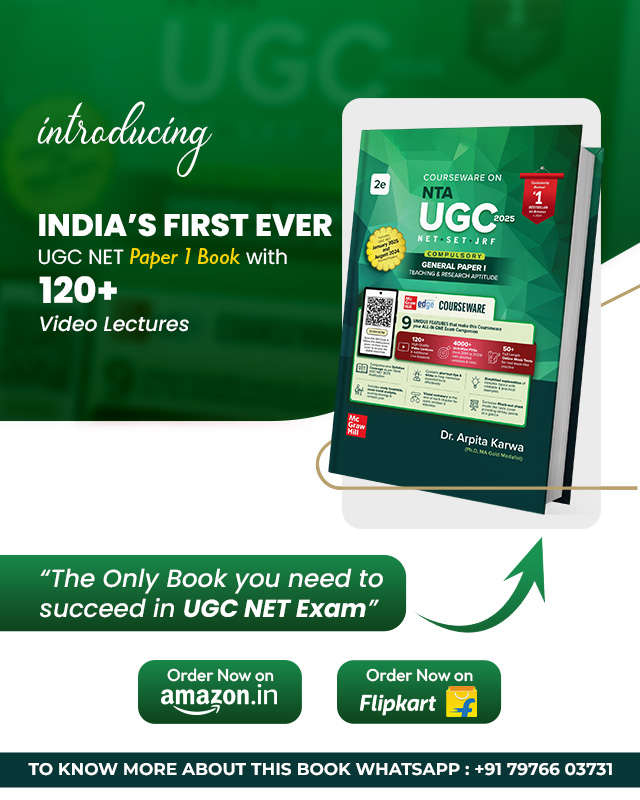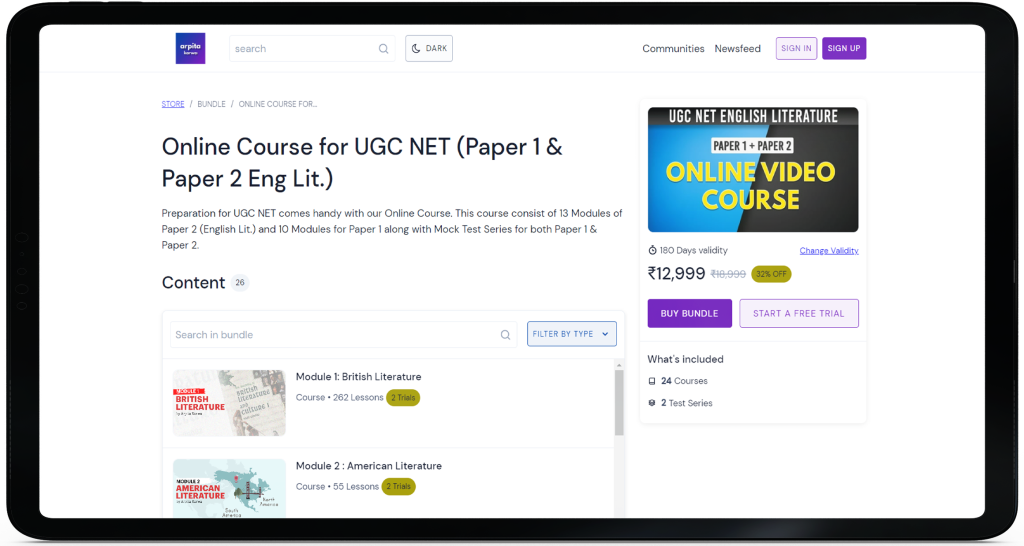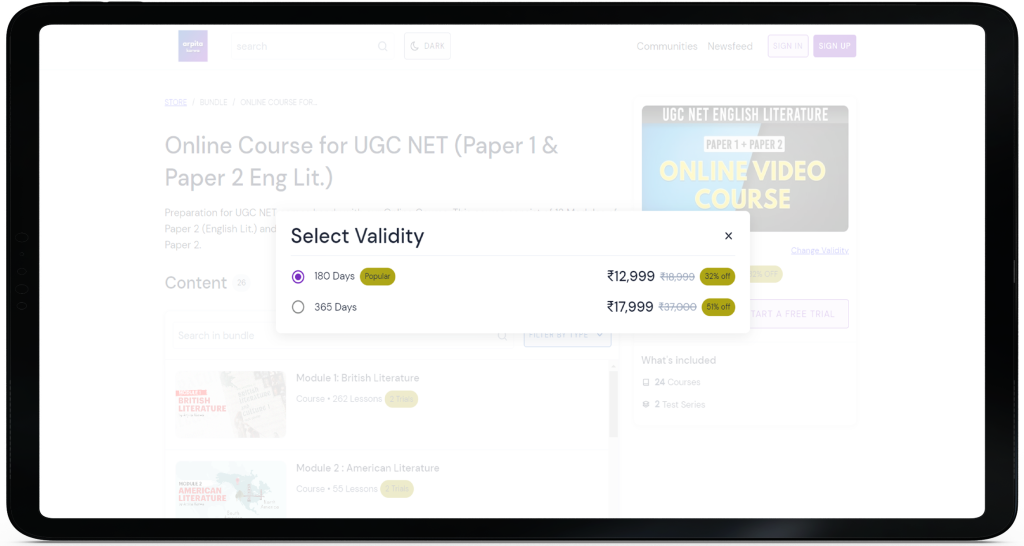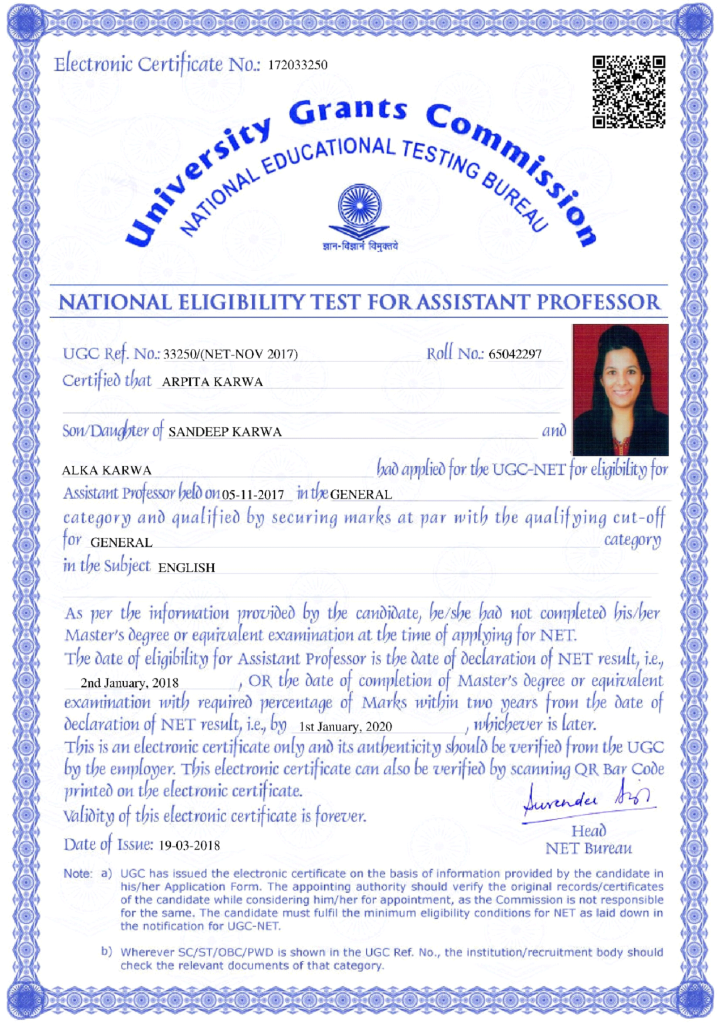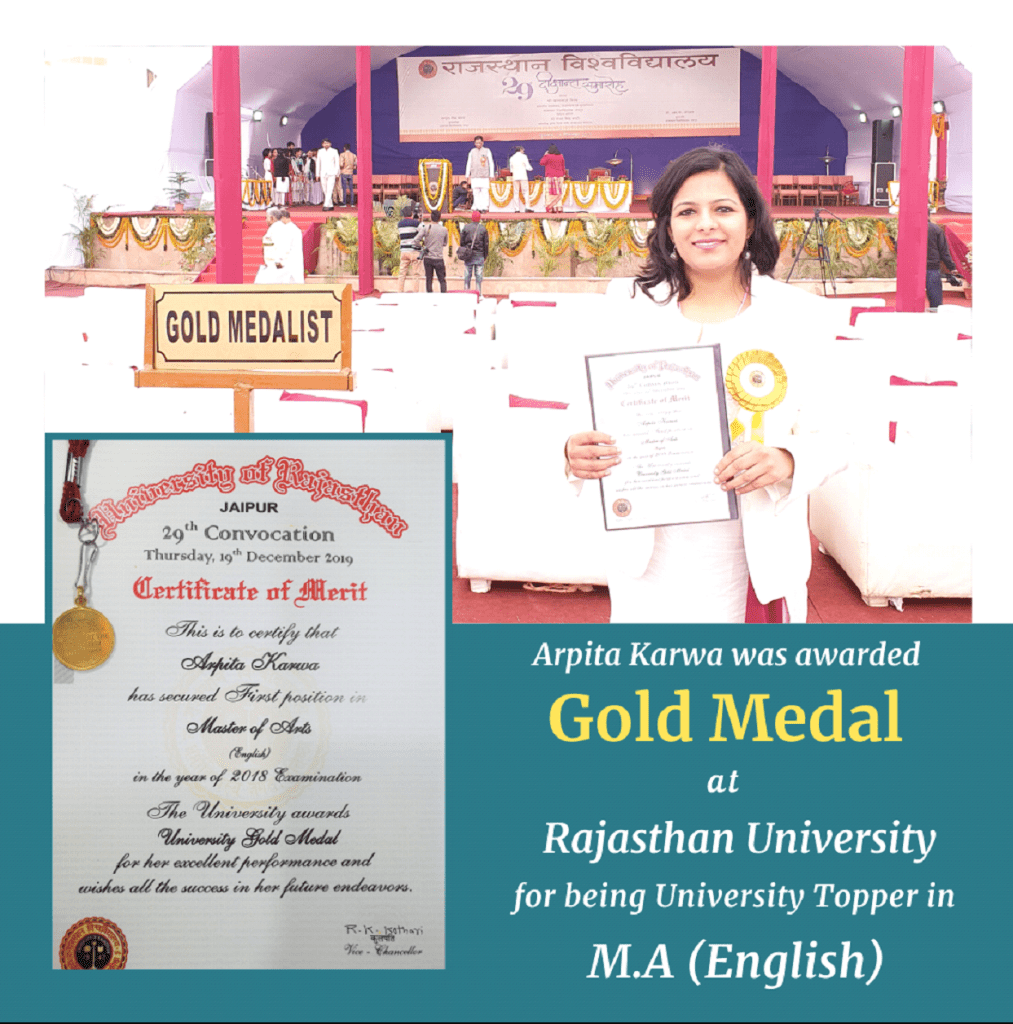Gujarat Set 3
June 20, 2023 2023-12-18 15:52Gujarat Set 3
Gujarat Set 3
Q.1) Samuel Butler’s “Hudibras is a satire on
(A) The Earl of Rochester
(C) The Friar of Westminster
(B) A Presbyterian Knight
(D) The Christian faith
Q.2) The Way of the World is written by…………
(A) George Farquhar
(B) George Etherege
(C) William Congreve
(D) William Wycherley
Q.3) The subject of Absalom and Achitophel is………
(A) Rebellion of the Duke of Monmouth
(B) Rebellion of Charles II
(C) Killing of the Pope
(D) Selling of the soul
Q.4) The birth of the human mind was “a white paper, void of all character, without y ideas” is a statement in the writings of ……………
(A) John Dryden
(B) Alexander Pope
(C) John Locke
(D) David Hume
Q.5) Alexander Pope in the Essay on Criticism deals with
(A) The merits and limitations of the 18″ century school of poetry
(B) The merits and limitations of the 18th century school of drama
(C) The merits and limitations of the 18th century school of criticism
(D) The merits and limitations of the 18″ century school of prose
Q.6) The Essay in which Dryden has compared Horace, Juvenal and Persius is……….
(A) Essay on Influence
(B) Essay on Criticism
(C) Essay on Ancients
(D) Essay on Satire
Q.7) Who of the following translated Homer’s Iliad?
(A) Alexander Pope
(B) William Congreve
(C) John Donne
(D) George Herbert
Q.8) The drama All For Love was written by……….
(A) Samuel Pepys
(B) John Dryden
(C) John Bunyan
(D) John Wilmot
Q.9) Which of the following is a play by John Bunyan?
(A) Atheist’s Tragedy
(B) The Shoemaker’s Holiday
(C) The Life and Death of Mr. Badman
(D) The White Devil
Q.10) ‘Sons of Ben’ signifies the poetry of……………
(A) Jacobean Poets
(C) The Cavalier Poets
(B) Elizabethan Poets
(D) Caroline Poets
Q.11) …………………..is a lampoon.
(A) Absalom and Achitophel!
(B) Adonais
(C) To His Coy Mistress
(D) The Rape of the Lock
Q.12) In Chaucer’s line “Whan that April, with his shoures soote/ The droghte of March hath perced to the roote And bathed every veyne in swich licour, Of which vertu engendredis the flour When Zephirus eck with his sweete breeth. Zephirus refers to……..
(A) North Wind
(B) South Wind
(C) West Wind
(D) Night Breeze
Q.13) “Confusion now hath made his masterpiece! Most sacrilegious murder hath broke The Lord’s anointed temple, and stole thence / The life of the building!” The given lines are from Shakespeare’s
(A) Macbeth
(B) King Lear
(C) Tempest
(D) Hamlet
Q.14) Tamburlaine was written by
(A) Edmund Spenser
(B) Walter Raleigh
(C) Christopher Marlowe
(D) Philip Sidney
Q.15) Defense of Poetry” is a seminal work of………….
(A) Thomas More
(B) Thomas Wyatt
(C) Philip Sydney
(D) Henry Howard
Q.16) The picaresque in English fiction is introduced by……….
(A) Lawrence Sterne
(B) Samuel Johnson
(C) Horace Walpole
(D) Daniel Defoe
Q.17) “True Wit is Nature to advantage dress’d / What oft was thought, but ne’er so well expressed”. “Wit’ here means……………
(A) Poetic insight
(B) Cleverness and intelligence
(C) Classical clarity
(D) Judgement
Q.18) The one who is not an Eighteenth-century writer is…………………
(A) Edmund Burke
(C) France Burney
(B) Samuel Pepys
(D) Oliver Goldsmith
Q.19) ‘Ode to Evening is written by
(A) Edmund Burke
(B) Thomas Gray
(C) William Collins
(D) Thomas Chatterton
Q.20) Swift held up to satirical review the claim of ancient and modern authors in
(A) A Modest Proposal
(B) The Battle of the Books
(C) Gulliver’s Travels
(D) Drapier’s Letters
Q.21) “He prayeth well, who loveth well Both man and bird and beast” are lines by……
(A) William Wordsworth
(B) ST. Coleridge
(C) Leigh Hunt
(D) Cardinal Newman
Q.22) Haydee in Don Juan is ……………
(A) Wife of Don Alfonso
(B) Daughter of a Greek pirate
(C) Princess of Constantinople
(D) A Duchess
Q.23) The background of Ivanhoe is the……….
(A) First crusade of Constantinople
(B) Contemporary life in Scotland
(C) Enmity between Saxon and Norman
(D) Conditions of Wales under Henry II
Q.24) Tennyson’s ‘Tears. idle Tears” was published as one of the songs in his……..
(A) The Lady of Shallot
(B) The Princess, In Memoriam
(C) Idylls of the King
(D) The Lotos Eaters
Q.25) Obi in Chinua Achebe’s No Longer at Ease is arrested for taking………..
(A) French leave
(B) His work seriously
(C) A second wife
(D) A bribe
Q.26) Which of the following novels of Dickens captured the French Revolution?
(A) Bleak House
(B) Our Mutual Friend
(C) A Tale of Two Cities
(D) Hard Times
Q.27) Dhiruben’s Gujarati play Bhavni Bhavai was translated into English by…..Ketan Mehta adapted it into a film by the same name and directed it.
(A) Shampa Banerjee
(B) Sandeep Mukherjee
(C) Deepa Mehta
(D) Yash Mehta
Q.28) ……..not a Victorian novelist.
(A) Elizabeth Gaskell
(B) George Eliot
(C) Jane Austen
(D) Anthony Trollope
Q.29) Heathcliff is a character in the novel………
(A) Jane Eyre
(B) Wuthering Heights
(C) Cranford
(D) Middlemarch
Q.30) ………………said. “Honest criticism and sensitive appreciation is directed not upon the poet but upon the poetry”.
(A) Northrop Frye
(B) W.B. Yeats
(C) T. S. Eliot
(D) LA. Richards
Q.31) Kim is a story of a child written by……….
(A) John Galsworthy
(B) Arnold Bennett
(C) Rudyard Kipling
(D) G. K, Chesterton
Q.32) The ancient Roman poet Ovid wrote Metamorphoses between……
(A) 16 BC and 1 AD
(B) 2 AD and 17 AD
(C) 4 AD and 17 AD
(D) 16 BC and 2 AD
Q.33) The novel having three parts named Mosque, Caves and Temple is……..
(A) The Longest Journey
(B) Howard’s End
(C) A Passage to India
(D) A Room with a view
Q.34) Joseph Conrad has not written………
(A) The Nigger of Narcissus
(B) Heart of Darkness
(C) The Secret Agent
(D) The Innocence of Father Brown
Q.35) Susan Bassnett enlists….types of ‘equivalence’ in her distinguished work Translation studies.
(A) Five
(B) Four
(C) Three
(D) Two
Q.36) “An idea of experience; it modified his sensibility”. This is Eliot discussing while formulating his notion of……………
(A) Donne ……… dissociation of sensibility.
(B) Marvell……… individual Talent
(C) Wordsworth……… tradition
(D) Ezra Pound…………… vers libre
Q.37) The editor of the famous literary journal Scrutiny which had a long run from 1932 to 1953 was…………
(A) L.C. Knights
(B) T.S. Eliot
(C) F.R. Leavis
(D) John Middleton Murry
Q.38) The following points:
(1) Direct treatment of the ‘thing’ whether subjective or objective.
(2) To use absolutely no word that does not contribute to the presentation.
(3) As regarding rhythm: to compose in the sequence of the musical phrase not insequence of a metronome.
Make the formal manifesto of the Movement…………
(A) Dadaist
(B) Surrealist
(C) Imagist
(D) Avant-Grade
Q.39) Epiphany means…………
(A) An author’s desire to rewrite his work again
(B) A sudden spiritual manifestation
(C) The moment of an author’s recognition in the society
(D) An author’s last words
Q.40) Ezra Pound’s major publication in 1920 was…………
(A) Hugh Selwyn Mauberley
(B) Homage to Sextus Properties
(C) The Cantos
(D) ABC of Reading
Q.41) ……………strongly opposed to a “tradition or allusions to mythology in poetry.
(A) Kingsley Amis
(B) Philip Larkin
(C) John Betjeman
(D) Sylvia Plath
Q.42) Dylan Thomas also wrote a work called ‘Portrait of the Artist, the complete title of which is……….
(A) Portrait of the Artist as a Young Man
(B) Portrait of the Artist as an Old Man
(C) Portrait of the Artist as a Young God
(D) Portrait of the Artist as a Young Dog
Q.43) The postmodern poet famous for writing on the fauna is………
(A) Scamus Heaney
(B) Paul Muldoon
(C) Ted Hughes
(D) Andrew Motion
Q.44) Rosencrantz and Guildenstern resurface back in ……………..
(A) Shakespeare’s last play The Two Noble Kinsmen
(B) Samuel Johnson’s essay “On the Courtiers Like Rosencrantz and Guildenstern”
(C) Tom Stoppard’s play Rosencrant and Guildenstern are Dead
(D) Bob Dylan’s song ‘Remembering Rosencrantz and Guildenstern”
Q.45) Kazuo Ishiguro’s novel on Japan rebuilding itself after World War ll is titled.
(A) A Pale View of Hills
(B) The Remains of the Day
(C) The Unconsoled
(D) Ar. Artist of the Floating World
Q.46) ‘ The Liberal Imagination, The Opposing Self and Beyond Culture are works by…..….
(A) Frank Kermode
(B) Malcolm Bradbury
(C) M.H. Abrams
(D) Lionel Trilling
Q.47) Inspired by Hemingway…………… went on to become the most famous Canadian writer of fiction in the mid-twentieth century.
(A) A.J.M.Smith
(B) E.J.Pratt
(C) Irving Layton
(D) Morley Callaghan
Q.48). ….. is recognised as the first Australian novel.
(A) The Life of an Exile
(B) First Fruits
(C) Quintus Servinton
(D) The Broad Arrow
Q.49) ….is recognised as the father of the South African poetry is English.
(A) Bishop Colenso
(B) Thomas Pringle
(C) R.C.Russell
(D) Charles Murray
Q.50) Omeros is now a canonical text of …….literature.
(A) South African
(B) Canadian
(C) Caribbean
(D) Australian
Q.51) A reader judging a poem through its emotional result on himself/herself is said to be suffering from….
(A) Historical fallacy
(B) Intentional fallacy
(C) Affective fallacy
(D) Normative fallacy
Q.52) Neo-Aristotelianism is associated with the University
(A) Venderbilt
(B) Chicago
(C) Princeton
(D) Washington
Q.53) That the primary aim of literature is a to `defamiliarize’ is a stance taken by….
(A) The Black Mountain School
(B) The Czech Surrealists
(C) The Yale Linguistic Circle
(D) The Russian Formalists
Q.54) On the observation “that there neither is, nor can be, any essential difference between the language of prose and metrical composition”,
(A) Southey and Coleridge agreed
(B) Wordsworth and Coleridge differed
(C) Coleridge and Hazlitt agreed
(D) Coleridge and Lamb differed
Q.55) Hermeneutics has a connection with the Greek god of translation and interpretation. Hermes. Among other things. Hermes is also the god of ……….…..
(A) Thieves
(B) Wizards and Witches
(C) Cooks
(D) Hangmen
Q.56) The art of storytelling is coming to an end. This is an observation made by ……..
(A) Jean Paul Sartre
(B) Gyorgy Lukacs
(C) Walter Benjamin
(D) Mikhail Bakhtin
Q.57) A critique of postmodernism by Marxist thinkers in the realm of the Arts is the obverse relationship between(the) …………
(A) History and reality
(B) Reality and representation
(C) Artefact and commodity
(D) Institutions and artefacts
Q.58) Deconstruction’s ancestry, philosophically, can be traced back to the Nietzschean contention that…….
(A) There are no facts
(B) There are many facts
(C) There are no facts, only their traces
(D) There are no facts, only interpretations
Q.59) Reader-response criticism distinguishes between the……
(A) Virtual and the real readers
(B) Passive and active readers
(C) Native culture and the foreign culture readers
(D) Implied and the actual readers
Q.60) Artificial Intelligence might be a character in……..
(A) Mixed Media
(B) Cyberpunk
(C) Space
(D) Netflick
Q.61) …… is an overall term for the growing class of novels which depart from realism and foreground the roles of the author in inventing the fiction.
(A) Antinovel
(B) Metafiction
(C) Parody
(D) Baroque
Q.62) The deliberate repetition of a word or phrase at the beginning of each line of verse or stanza is also known as ……
(A) Anaphora
(B) Cetaphora
(C) Anastrophe
(D) Catastrophe
Q.63) ………is another term for a line of seven iambic feet.
(A) Hexameter
(B) Monometer
(C) Heptameter
(D) Tetrameter
Q.64) In the line, “The moonlight steeped in silentness” from Coleridge’s The Rime of the Ancient Mariner, ‘steeped’ is a …..
(A) Metaphor
(B) Simile
(C) Hyperbole
(D) Transferred epithet
Q.65) “Love then her I did not / The dizzy day was so hot” is an example of ……………rhyme.
(A). Internal
(B). End
(C). Double
(D). Forced
Q.66). …………….is a humanistic approach developed by Caleb Gattegno in 1972.
(A) Community Language Learning
(B) Suggestopedia
(C) Silent Way
(D) Total Physical Response
Q.67) Bottom-up processing in listening is concerned with the activation of schemata alongside the deriving of meaning of spoken discourse.
(A) Approach
(B) Technique
(C) Method
(D) Plan
Q.68) The……………model of reading was developed by Rumelhart in 1977.
(A) Top-down
(B) Reiterative
(C) Bottom-up
(D) Interactive
Q.69) …… …were the two languages from which English borrowed during the Middle English Period,
(A) Celtic and Old Norse
(B) Latin and French
(C) Greek and Celtic
(D) Spanish and German
Q.70). ……. published Dissertations on the English Language (1784) which apparently set standard usage in American English.
(A) John Webster
(B) Noah Webster
(C) Merriam Webster
(D) Daniel Webster
Q.71) It was ………. who made finer distinction between ‘approach ”method’ and ‘technique’
(A) APR Howatt
(B) P.C.Wren
(C) H.E.Palmer
(D) Edward Anthony
Q.72) ……… learning is a kind of learning wherein students work in ‘a group of two of more to achieve a common goal’.
(A) Individual
(B) Collaborative
(C) Independent
(D) Cooperative
Q.73) …. in Bloom’s Taxonomy the use of a concept in a new situation or an unprompted use of an abstraction
(A) Analysis
(B) Synthesis
(C) Application
(D) Evaluation
Q.74) A native speaker´s know ledge of his/ her language is called
(A) Performance
(B) Grammaticality
(C) Appropriateness
(D) Competence
Q.75) The study of units of language and language use consisting of more than a single sentence. but connected by some system of related topics is known as….
(A) Phrase
(B) Syntactic
(C) Discourse
(D) Cohesion
Q.76) ….. wrote The Oresteiaian Triology.
(A) Menander
(B) Sophocles
(C) Aeschylus
(D) Euripede
Q.77) Alyosha is a character in Fydor Dostoevsky’s………
(A) Crime and Punishment
(B) The Brothers Karamazov
(C) The Idiot
(D) The Gambler
Q.78) ….……. advise Siddhartha in Herman Hessa’s Siddhartha to learn from the river’
(A) Vasudeva
(B) Kamaswami
(C) Gotama
(D) Govinda
Q.79) She Come to Stay is a novel by…..
(A) Brendan Behan
(B) Vicki Baum
(C) Charles Baudelaire
(D) Simone de Beauvoir
Q.80) Fedrico Garcia Lorca demonstrates his fascination with the conflict between human instincts and social restrictions in his play
(A) Yerma
(B) Blood Wedding
(C) Gypsy Ballads
(D) Lament for the Death of a Bullfighter
Q.81) Michael Madhusudan Dutt’s narrative poem ………….revealed Byronic influence.
(A) The Shair and other Poems
(B) Megnath Badha
(C) The Captive Ladie
(D) Fakir
Q.82) …… among Rabindranath Tagore’s rfovel approved English version was published in his own lifetime.
(A) The Crescent Moon
(B) The Wreck
(C) The Gardener
(D) Lover’s Gift
Q.83) Sri Aurobindo’s Savitri, A Legend and A Symbol is dived into …………
(A) 32
(B) 42
(C) 39
(D) 49
Q.84) R.K.Narayana’s ………………….Bachelor of Aris and The English Teacher are, for all practical purposes, a trilogy of Malgudi on Sarayu.
(A) Swami and Friends
(B) The Guide
(C) The Dark Room
(D) Waiting for the Mahatma
Q.85) Bhabhani Bhattacharya published…………. his first novel in 1947 after India became independent.
(A) He Who Rides a Tiger
(B) So Many Hungers
(C) Music for Mohini
(D) A Goddess Named Gold
Q.86) Indian Literature in English Translation is an important paper that helps students of English develop appreciation of our……………..literatures.
(A) National
(B) Local
(C) Regional
(D) Global
Q.87) Krishna Krishna by Indira Parthasarthy was translated into English by…….
(A) V. Ramanarayan
(B) Indira Parthasarathy
(C) K.S. Subramanian
(D) Padma Narayan
Q.88) Bhyrappa’s Kannada novel Sartha was translated into English under the title……………… by S.Ramaswamy.
(A) The Salesman
(B) The Charioteer
(C) The Specialist
(D) The Caravan
Q.89) The major problem with translating works lies in the difficulty in translating native into English.
(A) Syntax
(B) Lexes
(C) Idiom
(D) Sounds
Q.90) Bhishma Sahni’s award winning Hindi novel Tamas was translated as Darkness into English by…..
(A) Ram Ratan
(B) Ratan Shetty
(C) Jai Ratan
(D) Ratan Sharma
Q.91) Match the following characters in The Wasteland in A with the section in B where they appear in the poem:
A
(1) Albert
(2) Hieranymo
(3) Madame Sosotris
(4) Mr.Euqenides
B
(a) A Game of Chess
(b) The Fire Sermon
(c) What Fire Sermon
(d) The Burial of the Dead
Codes:
A. (1)-a, (2)-c, (3)-d, (4)-b
B. (1)-a, (2)-d, (3)-c, (4)-b
C. (1)-d, (2)-c, (3)-b, (4)-a
D. (1)-c, (2)-b, (3)-a, (4)-d
Q.92) Match the critics in A with the terms they are famously associated with in B:
A
(1) Antonin Artaud
(2) Antonio Gramci
(3) Jacques Derrida
(4) A.O.Lovejoy
B
(a) Hegemony
(b) History of Ideas
(c) Theatre of Cruelty
(d) Logocentric
Codes:
A. (1)-c, (2)-d, (3)-a, (4)-b
B. (1)-c, (2)-b, (3)-d, (4)-a
C. (1)-c, (2)-a, (3)-d, (4)-b
D. (1)-c, (2)-a, (3)-b, (4)-d
Q.93) Given below is a list of books and authors.
(Books)
(a) Things Fall Apart
(b) Wuthering Heights
(c) Vanity Fair
(d) The God of Small Things
(Authors)
(1) Emily Bronte
(2) W.M. Thackeray
(3) Arundhati Roy
(4) Chinua Achebe
…………is the correct order of authors as per the books (1 to 4)
(A) (4), (3), (1), (2)
(B) (2), (4), (3), (1)
(C) (4), (1), (2), (3)
(D) (3), (2), (4), (1)
Q.94) Given below is the list of novels and years of publication:
(Novels)
(a) Mill on the Floss
(b) Oliver Twist
(c) Jane Eyre
(d) Mary Barton
(Publication Year)
(1) 1838
(2) 1860
(3) 1837
(4) 1847
is the correct order of publication year as per the given novels (a to d).
A. (a)-4, (b)-2, (c)-1, (d)-3
B. (a)-1, (b)-3, (c)-4, (d)-2
C. (a)-3, (b)-2, (c)-1, (d)-4
D. (a)-2, (b)-3, (c)-4, (d)-1
Q.95) Given below are the lines from the poems and poets: (Lines)
(a) How should I greet thee? (b) If Winter comes, can Spring be far behind
(c) The meanest flower that blows can give Thoughts that do often to lie to deep for tears
(d) The Fancy cannot cheat so well As She is famed to do, deceiving elf
(Poets)
(1) John Keats
(2) William Wordsworth
(3) P.B. Shelley
(4) Lord Byron
…. is the correct order of the poets as per the given lines of the poem (a to d)
A. (a)-1, (b)-2, (c)-4, (d)-3
B. (a)-3, (b)-2, (c)-4, (d)-1
C. (a)-4, (b)-1, (c)-3, (d)-2
D. (a)-4, (b)-3, (c)-2, (d)-1
Read the following poem and answer the questions 96 to 100.
Nuns fret not at their convent’s narrow room;
And hermits are contented with their cells;
And students with their pensive citadels;
Maids at the wheel, the weaver at his loom
Sit blithe and happy; bees that soar for bloom,
High as the highest Peak of Furness-fells.
Will murmur by the hour in foxglove bells;
In trust the prison. Unto which we doom
Ourselves, no prison is: and hence for me
In sundry moods, was pastime to be bound
Within the Sonnet’s scanty plot of ground:
Pleased if some souls (for such their needs must be)
Who have felt the weight of too much liberty.
Should find brief solace there.as I have found.
Q.96) The rhyme scheme in this poem is …….
(A) abba, abba, cdccdc
(B) abab, abba, cddccd
(C) abba, abba, cddccd
(D) abba, abba, cddcdd
Q.97) Which of the following best describes the organization of the poem?
(A) A series of logically developing ideas with a concluding personal application
(B) A series of examples followed by a generalization and a personal application
(C) A generalization followed by examples
(D) A specific assertion followed by examples followed by a contradiction of the initial Assertion
Q.98) In line 3, the phrase “pensive citadels” can be best paraphrased as …..…
(A)Towers in which students’ area imprisoned
(B) Castles under siege
(C) Dreary fortresses
(D) Refuges for contemplation
Q.99) types of people are indicated in the poem.
(A) 3
(B) 4
(C) 5
(D) 6
Q.100) Lines 8-9 contain a………………..
(A) Hyperbole
(B) Personification
(C) Simile
(D) Paradox






